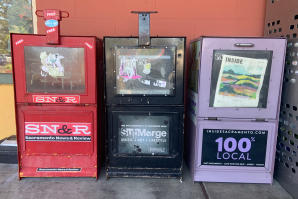In June 2019, Jeff vonKaenel spoke to PBS KVIE as his newspaper, the Sacramento News & Review, celebrated 30 years in business. At that time, he reiterated claims made over two decades prior in a front-page editorial titled “Mainstream Newspapers, R.I.P.” It’s the oldest article preserved on SNR’s website. In it, vonKaenel predicts dailies like The Sacramento Bee will disappear while his paper, a much smaller and cheaper operation, will survive.
“When the environment changes, bears don’t do very well. Mosquitoes, or other things, do just fine,” vonKaenel said on Studio Sacramento. As print media declined, he believed SNR would be “the last person standing.” About nine months later, something happened that no one could have predicted: A global pandemic. SNR stopped the presses, literally. Its print edition ceased as ad sales dried up.
“It was just painful,” vonKaenel told me. “We had to lay everybody off. We had to stop publishing, just instantly.” Years later and the mosquito did survive, not without losing a few legs and a wing. Most jobs were eliminated. The office was sold off. The print archive was donated. Its vendor boxes remain empty, but the SNR persists as a digital news outlet aided by a local journalism collective.
‘We’re back’
Scott Thomas Anderson soldiers on as SNR’s lone full-time journalist. He got his start interning at the paper, and years later, in 2016, was hired on as a crime reporter. Before COVID, there was a team of 10 journalists and graphic designers. Now it’s just him. Anderson was named editor by the end of 2021 (he’s also a contributor for Comstock’s magazine). Another writer in a different division sometimes offers assistance. For the most part, SNR’s articles are written by freelancers working for Solving Sacramento.
The collective launched in early 2022 with SNR as a founding collaborator. Its goal is to help sustain the region’s local news ecosystem. The seven current members include CapRadio, Sacramento Business Journal, The Sacramento Observer and Hmong Daily News. Each can submit their own stories for the others to republish and can also re-use any of the articles produced by the freelancers Solving Sacramento contracts. It’s a means to increase the amount of local content the partners have at their disposal.
Scott Thomas Anderson in a photo taken for his true crime
documentary podcast series “Trace of the Devastation.” (Courtesy
of Scott Thomas Anderson)

“We’re back to being in a pretty good place, because that Solving Sacramento experiment has panned out better than I ever imagined it would,” Anderson says. Of the top 10 most-read stories posted last year to SNR’s website, four came from Solving Sacramento and another four came from SNR’s pool of freelancers. Anderson authored the other two on the list.
The output level has returned, while the focus has shifted. The grants given to Solving Sacramento typically fund reporting on a specific topic, like the housing crisis or the creative economy. This means there’ll be times when SNR publishes a lot of content on that subject matter. Anderson said the tone of the writing from the collective’s freelancers is more akin to a traditional daily newspaper-of-record than an experimental alternative weekly like SNR. So it feels different, but it’s still news.
“A lot of grant funders out there are not looking to fund the next Tom Wolfe or Hunter S. Thompson, they’re looking to fund really specific journalism that’s helpful and meaningful to everyday people’s lives,” Anderson says. “That’s how it is, and we’re lucky they’re out there, you know? So right now, SNR is much more of a mainstream news publication since the pandemic.”
Anderson is fine with the change because SNR still has a separate freelancer budget it can use to fund the kinds of reporting others won’t, like long-form pieces up to 4,000 words, literary journalism and creative nonfiction. It’s much less than what Solving Sacramento can muster, but it makes a difference. “We still have the freedom to do really creative pieces.”
‘A two-newspaper city’
SNR made it through the pandemic. However, vonKaenel said he isn’t concerned with its long-term survival. What’s important to him is producing reliable information that helps the community. “Whether we do that with the News & Review or with Solving Sacramento, I don’t really care. What I do care about is making it happen.”
SNR still has a small office in Sacramento. VonKaenel doesn’t visit it much. These days, he spends most of his time on N&R Publications, his communications firm that primarily works with government agencies across the country, like adult schools and community colleges. The business is “using journalists to help tell their story, which has been really impactful, and we’re really proud of the work that we’re doing there,” vonKaenel says.
Seventy-four-year-old vonKaenel and his wife, Deborah Redmond, are still trying to figure out what to do with SNR. Right now, its future is undecided. What is certain for vonKaenel is that SNR will not resume its print edition anytime soon, if ever. He also doesn’t think SNR can become a self-sustaining business again.
“I don’t see a path there right now,” vonKaenel says. “I wouldn’t mind if I could run a four-minute mile, either. But how do we get there? I’m not seeing it.”
VonKaenel would like to pass on his news outlets. The owner of Coachella Valley Independent reached out about the Reno News & Review, and “we basically gave him the paper,” vonKaenel said. He hasn’t seen much interest in SNR or Chico News & Review. “There’s been not a lot of people knocking at the door.” It’s possible SNR could cease or merge with Solving Sacramento in some capacity.
Historically, Sacramento was served by two large dailies, the Sacramento Bee and the Sacramento Union. The Union ceased in 1994. Anderson said the SNR in some ways succeeded it as the city’s second general interest newspaper. He’d like it to continue fulfilling that role.
“It’s important for Sacramento, the capital of the fourth largest economy in the world, for it to be a two-newspaper city,” Anderson says, “even if one of those newspapers is an army of freelancers.”
Corrections August 27, 2025:
- A previous version of this article listed the number of Solving Sacramento members as eight. The current number of members is seven.
- A previous version of this article described Solving Sacramento as a nonprofit. It is not a nonprofit, but has a nonprofit fiscal sponsor.
- This version has been updated to include the name of Deborah Redmond, Jeff vonKaenel’s wife and co-founder.
–
Subscribe to the Comstock’s newsletter today.
Recommended For You

Can You Franchise the News? Media Entrepreneurs Say Yes
Franchise and license models like Edible and Coffee News offer turnkey options for would-be publishers
From McDonald’s to Ace Hardware, franchises permeate all sorts of industries, and media is no exception. The franchise model offers an onramp into the industry for entrepreneurs with the money but without the experience.

Local News Is Breaking. Can These Websites Fix It?
These local news sites are responding to the decline in legacy print newspapers
Many digital news outlets like the Folsom Times have popped up in the Capital Region over the past two decades. Are they destined to cease like the newspapers that came before them, or is it possible to build a local newsroom financially sustainable enough to last?

Local Journalist Receives $100,000 Grant to Support Hmong Daily News
Website covers an ethnic community that comprises about 1 percent of the Capital Region’s population
A coalition of funders is trying to save journalism, and one of the first to receive their aid is a little-known website serving a small ethnic community in Sacramento. Eighteen Press Forward grantees were based in California with only one in the Capital Region: Hmong Daily News.

The Man Who Buys the Capital Region’s Dying Newspapers
Paul Scholl has accumulated 18 print newspapers in under two decades
Paul Scholl started a newspaper about two decades ago to promote his services as a hospice chaplain. Now he brings relief to papers on their deathbeds. How did Scholl come to not only own 18 papers but to make them financially sustainable?

Page Not Found: Sacramento’s Disappearing Digital News
While libraries, museums and government archives preserve print copies of newspapers and magazines, news websites can disappear when the business closes
Digital permanence is a myth. Last year more than two newspapers closed a week on average in the United States, according to a report from the Medill School of Journalism at Northwestern University. When web hosting bills go unpaid, what happens to online content?



